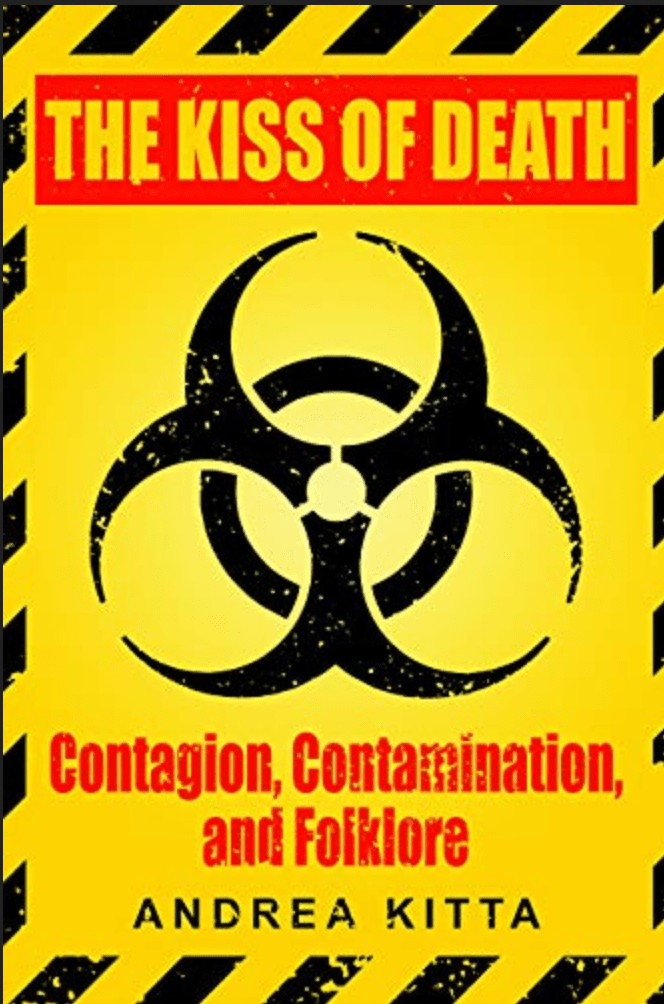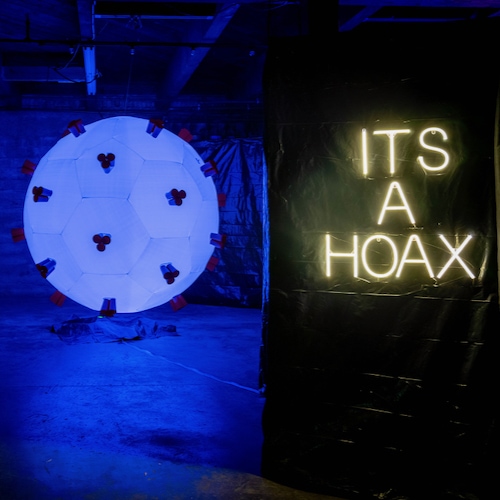 As the COVID-19 pandemic continues to ravage many places in the world, it is hard to imagine a book that is more timely or prescient than Andrea Kitta’s The Kiss of Death: Contagion, Contamination, and Folklore. The winner of the 2020 Brian McConnell Book Award and Chicago Folklore Prize, the author’s study of contemporary North American folklore begins with a somewhat unconventional question: what can beliefs in the supernatural, conspiracy theories, or anti-vaccination narratives tell medical and scientific institutions about how to meet their communities’ health needs in the wake of a contagious disease? It turns out, quite a lot.
As the COVID-19 pandemic continues to ravage many places in the world, it is hard to imagine a book that is more timely or prescient than Andrea Kitta’s The Kiss of Death: Contagion, Contamination, and Folklore. The winner of the 2020 Brian McConnell Book Award and Chicago Folklore Prize, the author’s study of contemporary North American folklore begins with a somewhat unconventional question: what can beliefs in the supernatural, conspiracy theories, or anti-vaccination narratives tell medical and scientific institutions about how to meet their communities’ health needs in the wake of a contagious disease? It turns out, quite a lot.
Interested in bridging the gaps between popular and medical assumptions about risk, The Kiss of Death seriously takes up epidemiological outbreak myths, legends, and rumors as modes of relating that help us understand the fears and doubts that can crop up in response to a disease. Kitta preempts any incredulousness that might emerge in the reader, arguing that these narratives powerfully shape perceptions, modify behavior, and in doing so, become “more than just folklore” as they move through the world (135). Mixing ethnographic and mixed media methods in a way accessible to both expert and lay audiences, Kitta dives into the ways disease, virus transmission, and death are social issues as much as medical ones. This approach, coupled with the diversity of her data, elegantly reveals over six chapters how many understandings of contagion are fundamentally about privilege and power.
What can beliefs in the supernatural, conspiracy theories, or anti-vaccination narratives tell us about how to meet our communities’ health needs in the wake of a contagious disease?
The book is structured in a somewhat linear fashion, tracing the various stages of a disease from first known infection to ultimate death. Each chapter centers around a different legend tied to the epidemiological—not just vampires or zombies, but also more mundane ones such as the act of killing someone with a severe allergy by kissing them after having eaten peanuts. In particular, Kitta is interested in exploring the ubiquity of these legends—which increasingly rival the information produced by medical and scientific institutions—and narrowing in on the forms of systemic discrimination like racism, misogyny, and homophobia at their core. In Chapter 2, “The Disease Is Coming from Inside the House! Contagious Disease, Immigration, and Patient Zero,” Kitta begins with the first known case of a disease, deftly contextualizing how outbreaks often result in attempts to place blame and stigmatize certain people, animals, and places. This can happen on both individual and structural levels. She discusses how “Patient Zero” does not necessarily actually designate the first person to be infected, but the first person who is traceable. Nonetheless, “Patient Zero” becomes a sense-making device in that their behavior is heavily scrutinized: this creates the impression that we know the source of the disease, giving us a false sense of control. Although it is less explicit in the assignment of blame, Kitta also speaks to the shifting spatiality of disease and how we emplace viruses within persons or specific places. Focusing on immigrants and those from other countries as figures of “diseased outsiders” in the H1N1, SARS, and 2015 Disneyland measles outbreaks, Kitta points to how common social media narratives and memes demonstrate how bodies are both racialized and made to be perpetrators or Patient Zero. This process notably occurs through systematic discourse that envisions white bodies as healthy and nonwhite bodies as inherently diseased. Hinting at a global mapping of disease, she cites characterizations of Ebola as an African disease on Twitter and Facebook as a particularly insidious example of this xenophobia, even though it only spread in a handful of countries and the number of those who contracted it were relatively low as compared to the continental population. Inversely, Kitta methodically traces how white bodies are Othered only through their behavior or by traveling to places perceived as the “third world”, where being infected is imagined as a punishment for social transgressions.
Kitta is interested in narrowing in on the forms of systemic discrimination like racism, misogyny, and homophobia at these legends’ core.
Readers will powerfully connect these discussions about who and what is made “risky” with their own recent lived experiences. The Kiss of Death, while published five months before the onset of COVID-19, takes on an almost medium-like quality in its ability to describe ongoing events. Kitta’s framing of the way disease is understood in North American culture as originating elsewhere immediately harkens to Donald Trump’s repeated labeling of COVID-19 as the “China disease” and the ensuing hate and discrimination directed at Asian-Americans.
Particularly concerned with the medical outcomes of these damaging social narratives, Kitta underlines the need for medical providers and scientific communities to take these beliefs—no matter how easily we might dismiss or belittle them—into consideration. This is especially true in an environment where people are much more likely to come across a xenophobic Facebook post or anti-vaccination Tweet than peer-reviewed information from organizations like the CDC. She asks, “How can medical institutions more effectively treat patients in areas perceived as dangerous and underserved? What can those in positions of power and authority do to improve health in all populations?” (44). Some proposed solutions include making cultural sensitivity a more integral part of science communication, addressing the paternalism of narratives aimed at dispelling medical disinformation (rather than labelling adherents as “stupid”), and renaming existing diseases to uncouple them from specific people, occupations, places, or species (which currently is the policy of the World Health Organization, but only for new diseases).
Kitta underlines the need for medical providers and scientific communities to take these beliefs into consideration.
As The Kiss of Death shows, blame is continually directed in ways that “takes the onus away from us” as a society to make changes about who gets sick or is subjected to violence (130). Moving to more-than-human monsters as figures that reflect these contemporary ideas of contagion, Kitta looks at two legends associated with suicide: Slender Man, the mysterious Internet legend who is conjured via thought, and a Lakota suicide spirit named Walking Sam spotted on the Pine Ridge Reservation in South Dakota. Kitta argues that some media outlets like The Daily Beast and social media commentators stigmatize mental illness by focusing on the mention of monsters rather than contextualizing these deaths within cyberbullying and systemic racism and poverty. Diving into the circumstances and Internet ephemera surrounding these deaths, she notes, “Folklore is often the target of action in such cases and, like video games or violence on television, provides an easy and convenient scapegoat” for broader social problems (53). Thoughts, rumors, and even violence may be contagious in ways that feel analogous to an infectious illness, and these stories certainly reveal certain truths about those who partake in them. However, as Kitta importantly underlines, treating folklore as something that takes on a life of its own furthers the idea that we have no agency or control over the stories we tell.
Kitta explores similar themes of virality by looking at anti-vaccination narratives, moralization, and what are considered “risky lifestyles” in Chapter 5, “Why Buy the Cow When the Milk Has HPV?”. Well-known controversies over the safety and efficacy of vaccines are woven throughout The Kiss of Death, reflecting that a significant number of North Americans cite folkloric narratives in their decisions to forgo medically recommended immunization schedules. In chapter 5, she describes specifically widespread rumors online and in celebrity discourses that the HPV vaccine is only for promiscuous women and gay men, citing an instance of even hearing this in a conversation with a family member who worried her son might be homosexual after a pediatrician recommended the vaccine. Illustrating how ubiquitous and close these narratives can be to readers’ lives, these discussions vividly document how ideas of risk exist within a much broader ecosystem of cultural knowledge and power. Whether it is opting out of a cancer-preventing vaccine or refusing to wear a face mask because it could be perceived as unmanly and weak, folklore plays a critical role in how those with privilege can come to make medical decisions in their attempts to distance themselves from identities or behaviors that society deems unacceptable.
These discussions vividly document how ideas of risk exist within a much broader ecosystem of cultural knowledge and power.
Overall, death and dying experiences and their roles in North American culture are comparatively less explicitly elaborated in this book. Kitta’s writing, alongside the evocative cover image and title, largely frames death as the ultimate risk outcome or endpoint of disease. Perhaps this merely reflects broader attitudes towards mortality in many Western societies, where death tends to be disavowed and hidden from view. However, a deeper articulation of the kinds of death featured in various chapters (which are both spectacular and mundane depending on disease and context) could have provided further contextualization to some of Kitta’s arguments. Nevertheless, throughout the book, Kitta weaves rich tales of intimacy, anxiety, and the very human need to explain and emplace disease and death. Gesturing towards questions of neocolonialism and the ways future diseases will be related to intensive global capitalism, The Kiss of Death invites us to interrogate our most deeply held cultural assumptions that the call is coming from outside the house, and makes persuasive assertions about why anthropologists, public health officials, and science communicators should take folklore and the structural inequalities they point to into more consideration.
Andrea Kitta, 2019. Kiss of Death: Contagion, Contamination, and Folklore. Utah State University Press.
Feature image: Photo (cropped) by Trevor Dykstra, on Flickr (CC BY-NC-SA 2.0).



